iPaaS Explained
BLOG
Can you imagine not being able to give your customers the experiences they look for because your systems are stuck in the past? This is often the reality when businesses rely on outdated, clunky legacy systems that can’t keep up with the changing business needs. These systems create data silos, making it tough to integrate new technologies and deliver seamless experiences.
What’s driving successful businesses today is the ability to integrate various systems smoothly, especially now, with AI optimizing so many aspects of work. Consistent integration is not just nice to have; it is essential. When done right, it means you can use your data to gain insights, innovate, and deliver best digital experiences.
This is where iPaaS makes a difference. It is like a support cable that you can use to leap over the challenges of legacy integration systems and dive into digital transformation. Basically, iPaaS makes integration easy, efficient, and effective.
Before we dive in further to explore all about how iPaaS is a significant part of modern integration, we want you to think about one quick question.
Are legacy systems holding your business back from reaching its full potential?
Talk to Our Experts Today!What Are Legacy Systems?
To understand the need for iPaaS, let’s start with the basics. So, what is a legacy system? A legacy system is outdated technology that still supports the critical day-to-day operations of an organization. These systems often serve as the backbone of an organization but are inflexible and obsolete. Developed years ago, legacy systems rely on old architectures and complex codes, making integration with newer technologies difficult.
Maintaining legacy systems is resource-intensive and costly. According to a study, legacy systems consume up to 60 to 80% of the IT budget just to keep them running. To keep up with the technological advancements and meet customer expectations, organizations need to replace legacy applications and systems. However, replacing these systems and adopting new technology is a significant challenge. Other major concerns for organizations considering modernization include security, availability, and scalability.
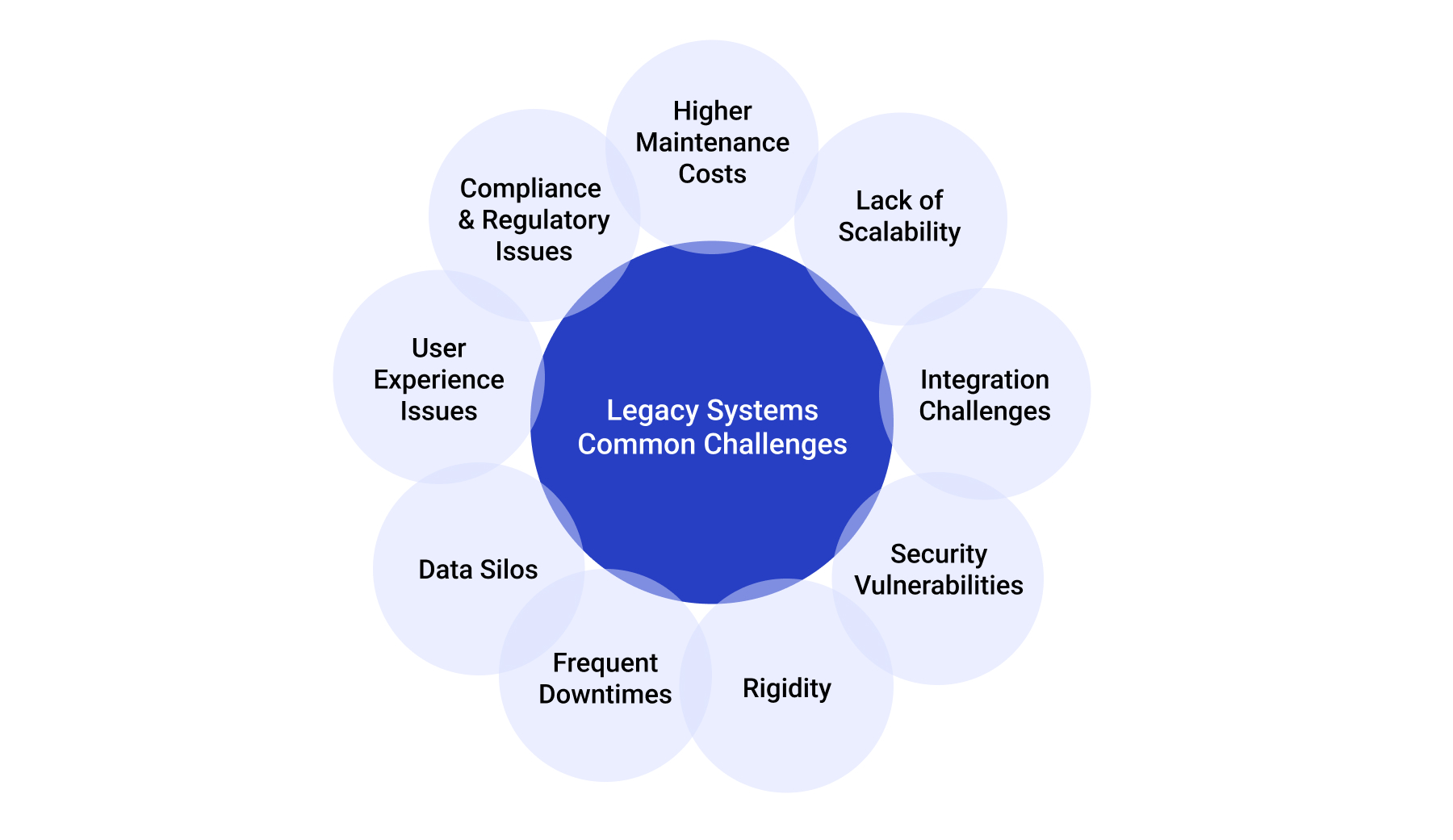
While foundational to many organizations, legacy systems often come with several pain points that can hinder business operations and growth. Some common issues associated with legacy systems are:
- Higher Maintenance Costs: Frequent maintenance and the need for specialized, skilled resources drive up costs.
- Lack of Scalability: Design and architecture limitations prevent scalability.
- Integration Challenges: Difficulty integrating with modern systems and applications makes them incompatible and prone to error.
- Security Vulnerabilities: Outdated security protocols and lack of updates pose significant security risks.
- Rigidity: Legacy systems are slow to adapt to new business needs or market changes, reducing agility.
- Frequent Downtimes: Failures, outages, and slower processing speeds result in poor performance and reliability.
- Data Silos: These systems often create isolated data silos, causing duplication and inconsistencies in data.
- User Experience Issues: Non-intuitive interfaces and extensive training requirements hamper user experience.
- Compliance and Regulatory Issues: Non-compliance with current regulatory standards leads to auditing difficulties.
What is iPaaS?
Now that we have a fair understanding of legacy systems and how they hold businesses back, let’s dive into what iPaaS is.
According to Gartner, “Integration Platform as a Service (iPaaS) is a suite of cloud services enabling development, execution, and governance of integration flows connecting any combination of on-premises and cloud-based processes, services, applications and data within individual or across multiple organizations.”
Simply put, iPaaS is a cloud-based service that enables end users and organizations to integrate various data sources, services, and applications. It is a platform solution that connects these disparate entities, both internal and external to the organization. It is a solution that simplifies these connections by integrating applications that may be on-premises and on the cloud through pre-built connectors and APIs.
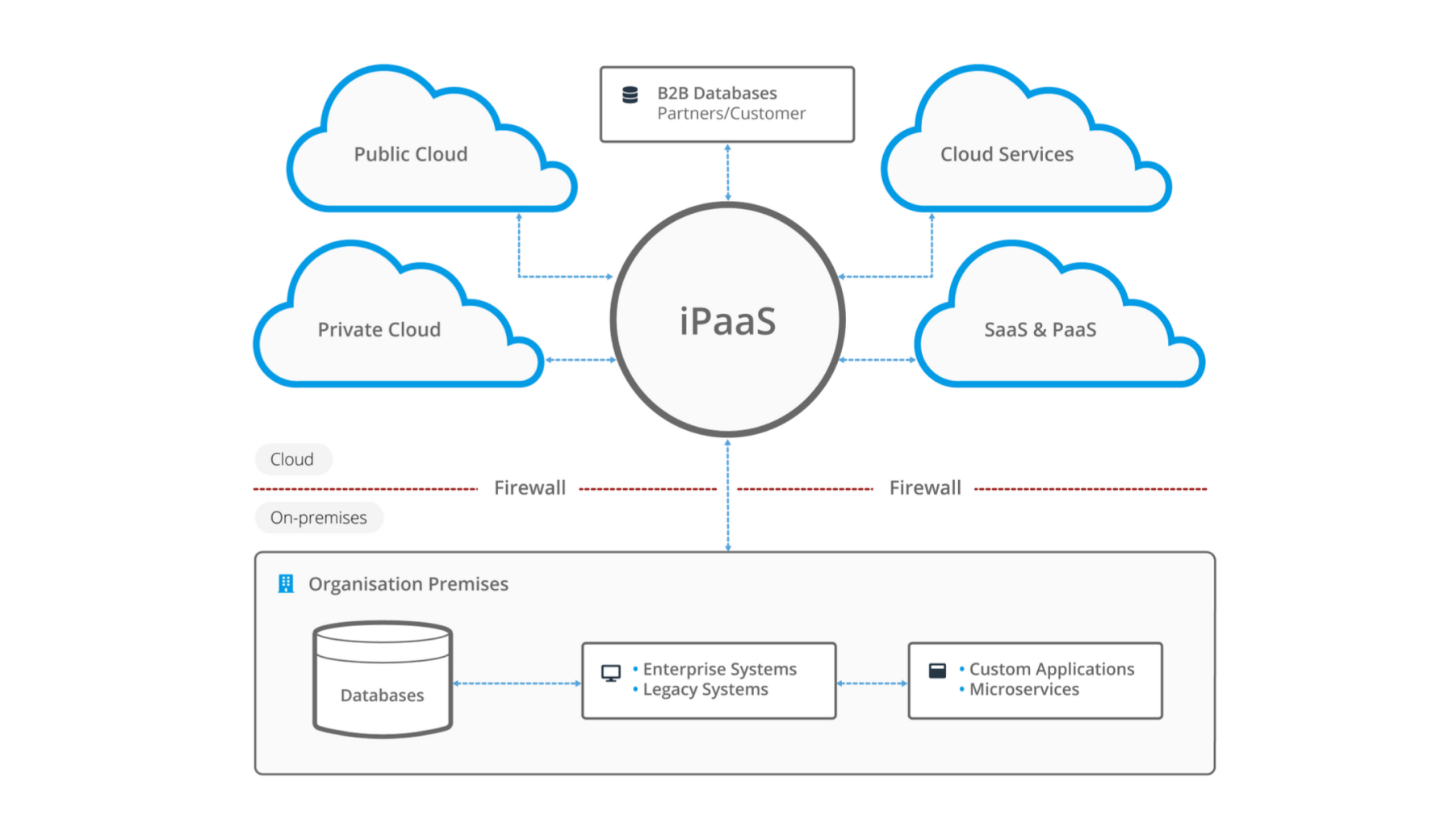
So, what iPaaS exactly does? iPaaS enables users to streamline and optimize various business processes. This includes capabilities for:
- Ensuring data consistency across disparate applications and systems.
- Enabling real-time data synchronization by consolidating data.
- Bridging the gap between on-premises systems and cloud applications.
- Facilitating complete API or event lifecycle for the existing systems.
- Assuring security and compliance by adhering to standard practices.
- Providing monitoring and management capabilities through a unified platform.
iPaaS is a one-stop solution that leverages these capabilities and enables organizations to streamline their integration processes, reduce time-to-market, improve operational efficiency, and adapt quickly to changing business needs.
Need personalized assistance?
Reach Out to Us Today!Benefits of iPaaS
It is necessary to understand the advantages that iPaaS integration brings to the table beyond its capability of connecting disparate applications and systems and integration consistency.
Here are some of the key benefits.
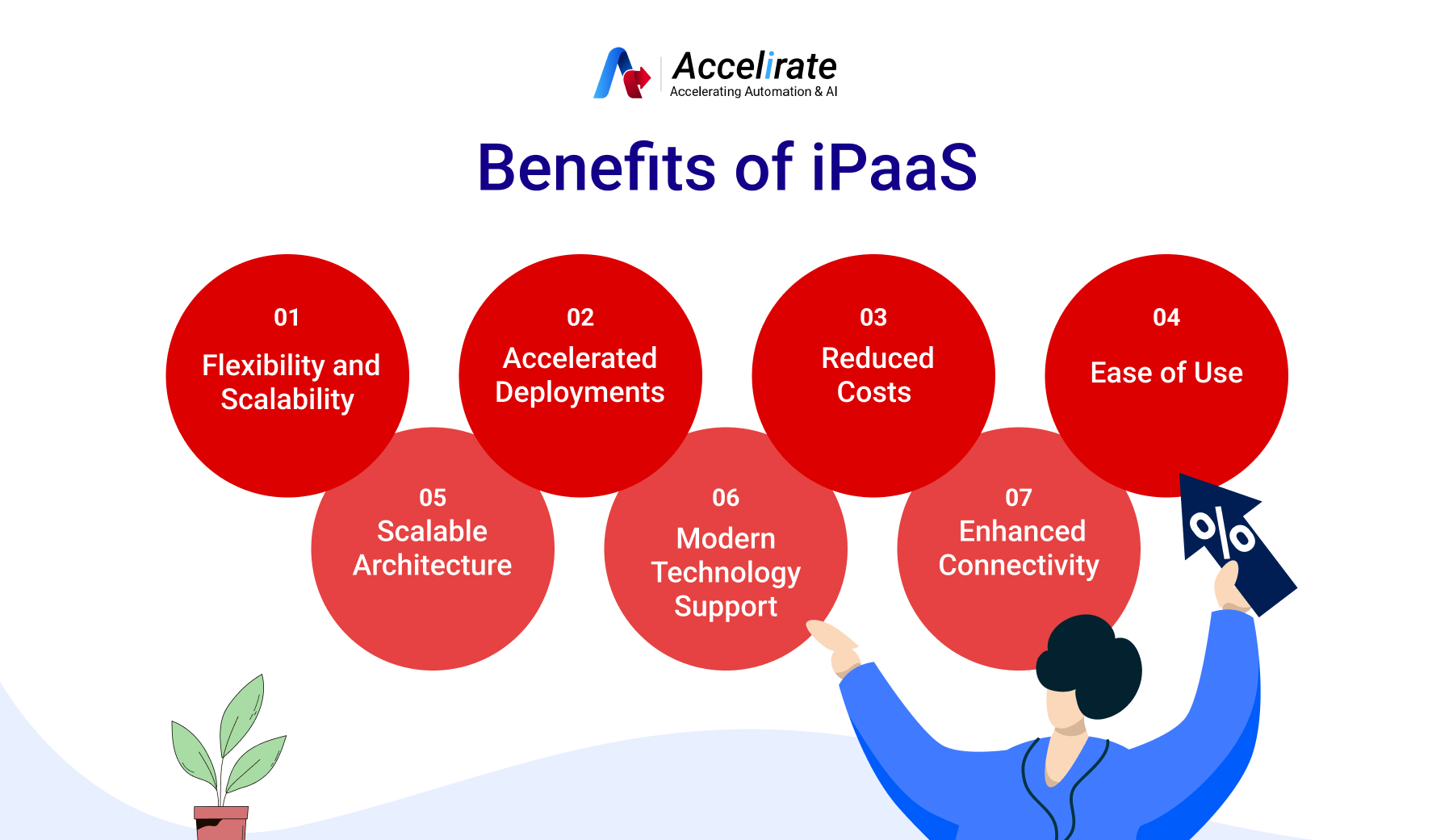
- Flexibility and Scalability: iPaaS offers immense flexibility and scalability compared to legacy systems. It allows businesses to quickly adapt to changing requirements, add new integrations, and scale up or down as needed without significant overhead.
- Accelerated Deployments: iPaaS solutions typically have faster deployment times compared to traditional integration methods. With features like pre-built connectors and templates, the time and effort required to connect disparate systems is significantly reduced.
- Reduced Costs: iPaaS eliminates the need for costly infrastructure investments and the ongoing maintenance and upgrades associated with legacy systems. Businesses can pay for only the services they use on a subscription or pay-as-you-go basis, reducing upfront costs and providing predictable pricing.
- Ease of Use: Designed to be user-friendly, iPaaS platforms feature intuitive interfaces and drag-and-drop functionality. This makes it easier for non-technical users to create and manage integrations without relying on IT support.
- Scalable Architecture: iPaaS architecture is inherently designed to be more scalable and resilient than traditional legacy systems. It leverages cloud infrastructure, which can dynamically allocate resources to handle varying workloads and ensure high availability.
- Modern Technology Support: iPaaS solutions often support modern technologies such as APIs, microservices, and event-driven architecture. This enables businesses to leverage the latest innovations in integration and automation to drive digital transformation initiatives.
- Enhanced Connectivity: iPaaS provides a centralized platform for managing integrations across hybrid IT environments, including cloud-based applications, on-premises systems, and legacy applications. This allows businesses to achieve greater connectivity and interoperability between different systems and data sources.
Wondering how much time and money you could save by switching to iPaaS?
Let’s Discuss!Real-World Application of iPaaS
iPaaS offers a modern approach to integration that addresses many of the limitations of legacy systems, enabling businesses to streamline their operations, improve agility, and accelerate innovation.
From a statistical perspective, organizations that have implemented iPaaS report significant benefits, including:
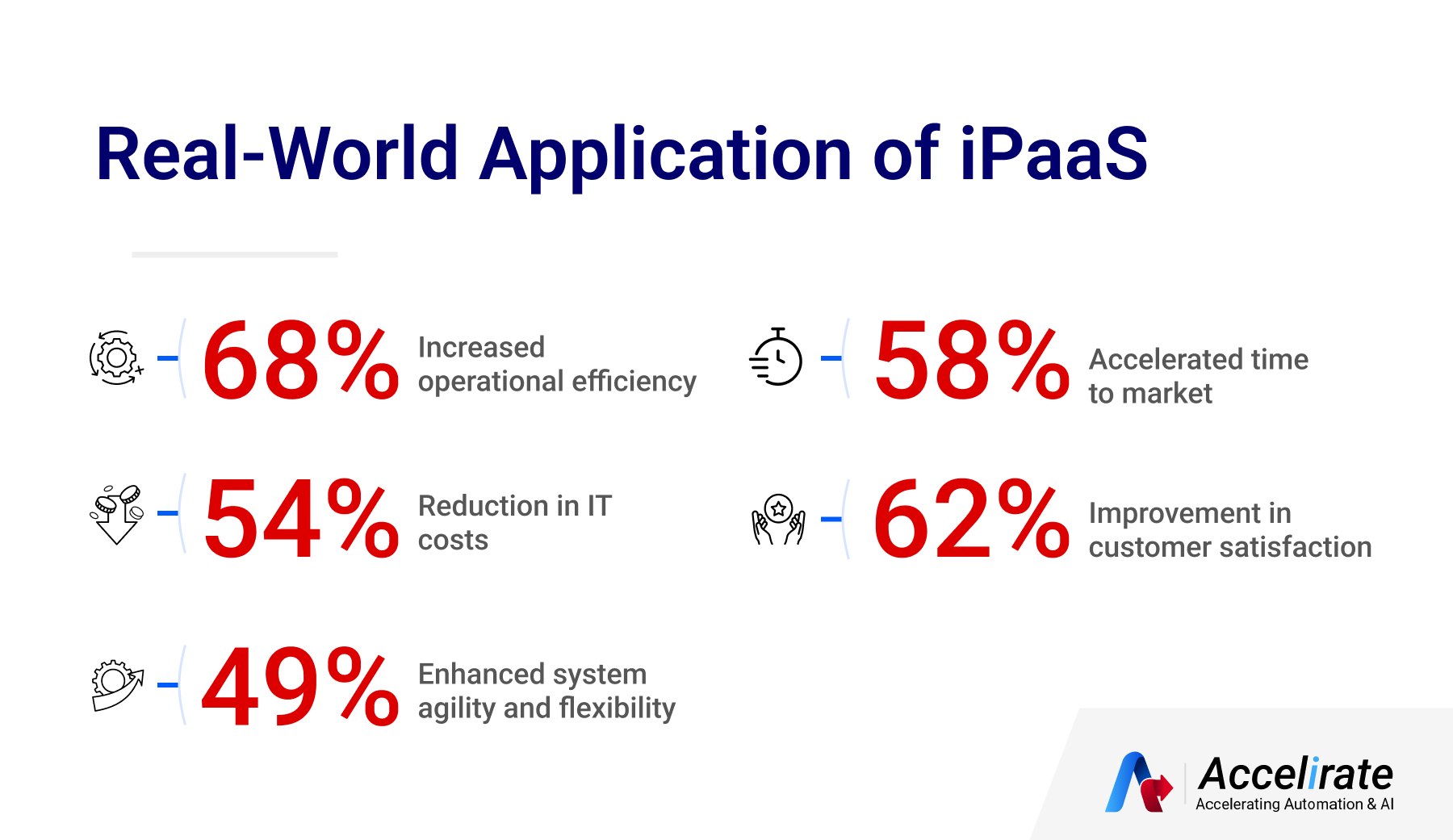
What Makes MuleSoft a Preferred iPaaS Solution?
MuleSoft has been a consistent leader in the market with its strong strategy and extensive offerings. MuleSoft, with its current iPaaS offering, continues to innovate and grow, providing a wide range of services and products for seamless integration, automation, and API management capabilities. It is known for its comprehensive suite of tools designed to connect applications, data, and devices both on-premises and in the cloud. Here are some key features and capabilities of MuleSoft as an iPaaS solution:
- AnypointPlatform: MuleSoft's Anypoint Platform is a unified, flexible integration platform that enables businesses to build, manage, and optimize their integration solutions.
- Robust API Management: MuleSoft offers robust API management capabilities, allowing businesses to design, deploy, and manage APIs effectively.
- Data Integration: It excels in integrating data from various sources, whether they are on-premises or in the cloud.
- Seamless Application Integration: MuleSoft enables the seamless integration of on-premises and cloud-based applications with its extensive range of pre-built connectors and tools for integration.
- Scalability and Performance: The platform is designed to scale and perform under varying workloads.
- Event-Driven Integration: Support for event-driven integration allows businesses to respond in real-time to changes and events.
- Security and Compliance: MuleSoft ensures that integrations are secure and compliant with industry standards.
- User-Friendly Interfaces: With its low-code/no-code interfaces and comprehensive dashboards, MuleSoft provides tools that cater to both technical and non-technical users.
MuleSoft as an iPaaS solution provides a powerful and flexible platform for integrating a wide range of applications, data sources, and devices. Its comprehensive suite of tools and features helps organizations increase productivity by 64% and accelerate deployments by a whopping 78%. By leveraging MuleSoft, businesses can overcome the limitations of legacy systems and embrace modern, scalable integration strategies.
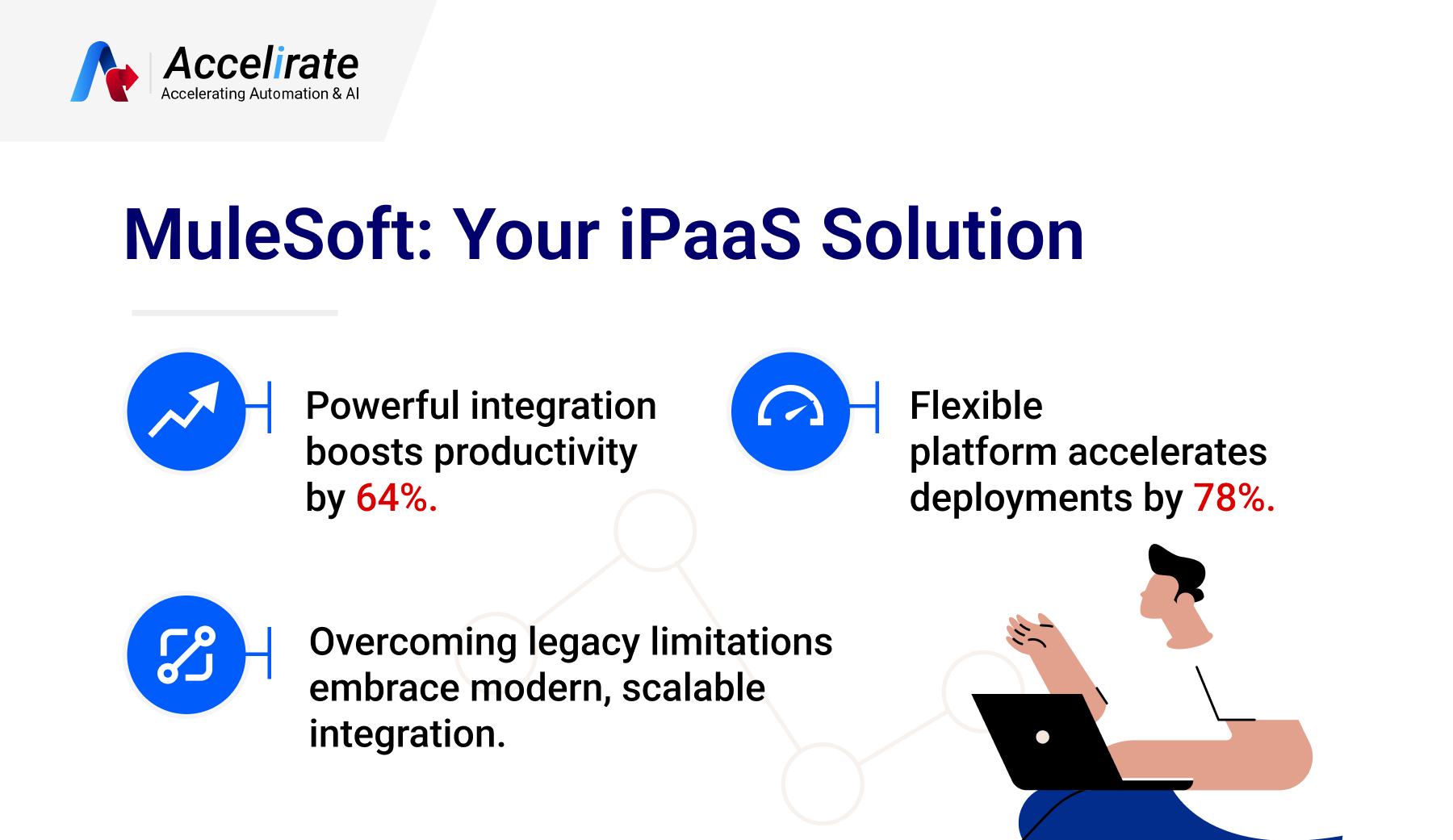
Let’s Level Up Your Integration Capabilities with iPaaS
There is no denying that iPaaS is the most beneficial solution for meeting the data integration needs of organizations. As the fastest-growing enterprise software segment, iPaaS consistently tops customer satisfaction charts year after year. It stands out as a powerful tool that addresses the limitations and challenges posed by outdated legacy systems. With its capabilities, iPaaS enables organizations to seamlessly integrate diverse applications and data sources, making your operations more efficient and fostering innovation.
Tired of high maintenance costs and security issues with your old systems? Transitioning from legacy systems to iPaaS helps you reduce these costs, enhance your security, and speed up your digital transformation efforts.
That’s not all. By adopting iPaaS, companies can stay competitive, responsive, and agile, meeting the demands of modern business environments and driving growth and success in an increasingly inter-connected world. So, if you are looking for the right solution to upgrade your business operations? Now is the time! With a trusted iPaaS provider like Accelirate, you can kickstart your iPaaS implementation in the most effective way.
Let’s work together and see all the amazing changes iPaaS can bring!

